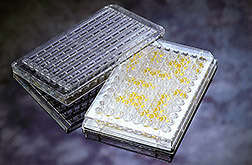Averting Fishkill
Diagnostic kit detects deadly catfish disease.
A mud-dwelling pathogenic bacterium that wreaks havoc with catfish farmers' finances is about to be unmasked by a pondside test that can detect the bacterium's presence in as little as half an hour.
Mortality among catfish infected with Edwardsiella ictuluri—and the resultant enteric septicemia—can run as high as 50 percent. But the bacterium's devastating effects reach even further: Fish farmers, uncertain whether the organism is about to strike, try to fight back with costly antibiotic-dosed fish feed, but still suffer losses because of the rapid onset of this disease.
"You can detect infection with E. ictuluri in a fish because the fish's immune system makes antibodies against the bacterium," explains microbiologist Phillip H. Klesius, who is located at the ARS Fish Diseases and Parasites Research Laboratory in Auburn, Alabama.
|
|
"We've developed a diagnostic kit to detect the first appearance of the antibody. That's the most effective time to treat, because once the fish actually get enteric septicemia, they go off their feed and won't eat enough. We want to accomplish strategic use of the medicated feed, and this kit can tell the farmer when to act."
Klesius' diagnostic kit uses a tiny bit of the bacterium itself--an antigen present on the bacterium's surface. A few drops of a fish's blood are exposed to the antigen in the test kit. If the fish has been infected with E. ictuluri, its immune system will have produced antibodies against that antigen, and those antibodies in the blood will attach to the antigen in the diagnostic kit.
Diagnostics, Inc., of Wilton, Connecticut, has acquired a license from ARS to commercialize the monoclonal antibody developed by Klesius to recognize the E. ictaluri antigen. The test kit is expected to be commercially available within the next 18 months.
Pursuing his idea even further, Klesius is now developing a monoclonal antibody that will pinpoint the E. ictaluri itself in the fish.
"This would allow even earlier detection—within a day of infection," he says. "It takes the fish's immune system a couple of days to make the antibodies that are detected by our current kit."
The ability to fine-tune timing of medicated feeds offers two benefits, Klesius points out.
"First, there's increasing resistance within E. ictaluri against the two antibiotic treatments now approved for use," he notes. "By reducing use to only when the feeds are really needed, we could help avoid that resistance problem."
The more obvious advantage is the savings to the farmers. They could make up to 10 percent more than they're getting now, because they wouldn't be losing fish or fish growth to the enteric septicemia. And they would be saving money by cutting down on the amount of medicated feed used.
"The earlier you intervene, the more effective you will be," Klesius says. "We have to get away from waiting to treat the disease, for if you act when there aren't as many organisms present, there's less likelihood of creating those antibiotic-resistant E. ictaluri.'" — By Sandy Miller Hays, ARS.
Phillip H. Klesius is at the USDA-ARS Aquatic Animal Health Research Laboratory, 990 Wire Road, Auburn. AL 36831-0952; phone (334) 887-3741, fax (334) 887-2983.
"Averting Fishkill" was published in the March 1995 issue of Agricultural Research magazine.







